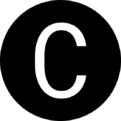 Logo on Carbon's GitHub organization | |
| Family | C |
|---|---|
| Designed by | |
| Typing discipline | Static, nominative, partly inferred |
| Implementation language | C++ |
| License | Apache-2.0-with-LLVM-Exception |
| Filename extensions | .carbon |
| Website | github |
| Influenced by | |
| C++, Rust, Swift [citation needed] | |
Carbon is an experimental programming language designed for connectiveness with C++.[1] The project is open-source and was started at Google. Google engineer Chandler Carruth first introduced Carbon at the CppNorth conference in Toronto in July 2022. He stated that Carbon was created to be a C++ successor.[2][3][4] The language is expected to have an experimental MVP version 0.1 in 2025 and a production-ready version 1.0 after 2027.[5]
The language intends to fix several perceived shortcomings of C++[6] but otherwise provides a similar feature set. The main goals of the language are readability and "bi-directional interoperability" (which allows the user to include C++ code in the Carbon file), as opposed to using a new language like Rust, that, whilst being influenced by C++, is not two-way compatible with C++ programs. Changes to the language will be decided by the Carbon leads.[7][8][9][10]
Carbon's documents, design, implementation, and related tools are hosted on GitHub under the Apache-2.0 license with LLVM Exceptions.[11]
Example[edit]
The following shows how a program might be written in Carbon and C++:[12]
| Carbon | C++ |
|---|---|
package Geometry;
import Math;
class Circle {
var r: f32;
}
fn PrintTotalArea(circles: Slice(Circle)) {
var area: f32 = 0;
for (c: Circle in circles) {
area += Math.Pi * c.r * c.r;
}
Print("Total area: {0}", area);
}
fn Main() -> i32 {
// A dynamically sized array, like `std::vector`.
var circles: Array(Circle) = ({.r = 1.0}, {.r = 2.0});
// Implicitly converts `Array` to `Slice`.
PrintTotalArea(circles);
return 0;
}
|
#include <numbers>
#include <print>
#include <span>
#include <stdfloat>
#include <vector>
// or: import std;
struct Circle {
std::float32_t r;
};
void PrintTotalArea(std::span<Circle> circles) {
std::float32_t area = 0;
for (const Circle& c : circles) {
area += std::numbers::pi * c.r * c.r;
}
std::print("Total area: {}\n", area);
}
int main() {
std::vector<Circle> circles{{.r = 1.0}, {.r = 2.0}};
// Implicitly converts `vector` to `span`.
PrintTotalArea(circles);
return 0;
}
|
See also[edit]
References[edit]
- ^ "README". Retrieved 6 September 2023.
It is designed around interoperability with C++ as well as large-scale adoption and migration for existing C++ codebases and developers.
- ^ "Scheduled events for Tuesday, July 19, 09:00 - 10:30". CppNorth, The Canadian C++ Conference, July 17–20, 2022. CppNorth. Retrieved 21 July 2022 – via Sched.com.
- ^ "Carbon Language: An experimental successor to C++ - Chandler Carruth - CppNorth 2022". CppNorth. 22 July 2022 – via YouTube.
- ^ Bradshaw, Kyle (19 July 2022). "Carbon, a new programming language from Google, aims to be C++ successor". 9to5Google.
- ^ Carbon Language: Roadmap, carbon-language, 11 January 2024, retrieved 18 January 2024
- ^ "Difficulties improving C++". carbon-language/carbon-lang repo. Google. 21 July 2022 – via GitHub.
- ^ Carruth, Chandler; Ross-Perkins, Jon; Riley, Matthew; Hummert, Sidney (23 July 2022). "Evolution and governance". carbon-language/carbon-lang repo. Google – via GitHub.
- ^ Illidge, Myles (21 July 2022). "Google's Carbon programming language aims to replace C++". MyBroadband.
- ^ Jackson, Joab (20 July 2022). "Google Launches Carbon, an Experimental Replacement for C++". The New Stack.
- ^ Mustafa, Onsa (20 July 2022). "Carbon, A New Programming Language from Google As A C++ Successor". PhoneWorld.
- ^ "carbon-lang/LICENSE". GitHub. 16 June 2020. Retrieved 24 July 2022.
- ^ "carbon-lang/docs/images/snippets.md at trunk · carbon-language/carbon-lang". GitHub. Retrieved 16 December 2023.
External links[edit]
Well, that’s interesting to know that Psilotum nudum are known as whisk ferns. Psilotum nudum is the commoner species of the two. While the P. flaccidum is a rare species and is found in the tropical islands. Both the species are usually epiphytic in habit and grow upon tree ferns. These species may also be terrestrial and grow in humus or in the crevices of the rocks.
View the detailed Guide of Psilotum nudum: Detailed Study Of Psilotum Nudum (Whisk Fern), Classification, Anatomy, Reproduction